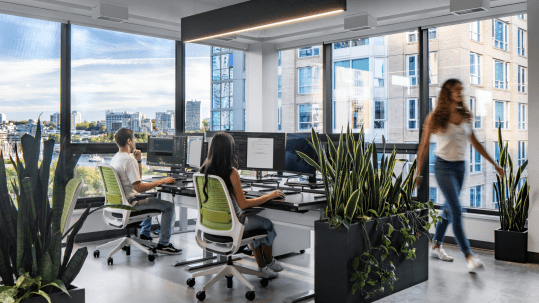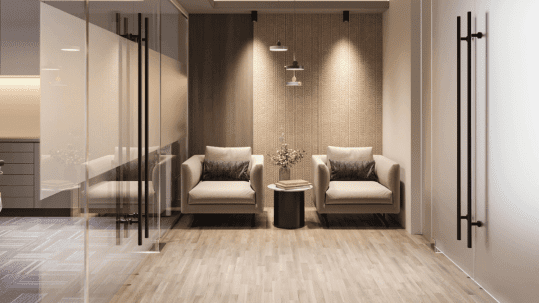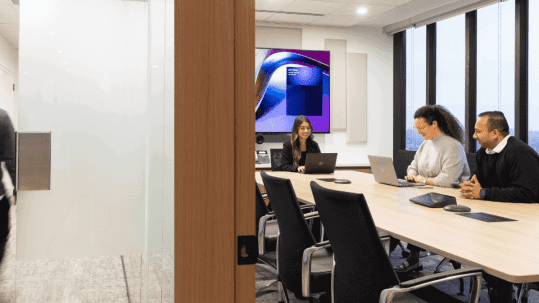When it comes to the design and architecture of the future, change is vital. Occupants require change and designers must redesign environments to meet those expectations. Our workplaces have transitioned from windowless rooms filled with cubicles to inviting workspaces that rejuvenate and inspire. Before we look forward to the future of office environments, let’s look at where we started.
Open Office Design of the Past
If there was one style that was utilized tirelessly throughout the decades, it was the advent of the open office. This idea was created roughly in the mid to early 20th century as a way to develop spacious workstations. The open office removed borders and other walls to improve interactions between coworkers and improve company morale. Although this setup sounds ideal, it did have quite a few challenges. When this design became popular during the mid-1900s, the setup had more resemblance to a factory with long rows of desks that were packed with workers. Although the open office wasn’t necessarily a failure, it did set the groundwork for what was to come.
The Cubicle
Many individuals think cubicles should belong in a museum. However, the cubicle was designed with one goal: empowering employees. It was a rebuttal to the open office layout and it was an answer to many of its problems. For starters, the cubicle allowed workers some privacy in their workspace. Instead of employees being stuffed into tight spaces with one another, employees could have their own dedicated space. In addition to this, the cubicle allowed personalization to one’s workspace. It optimized productivity and had a promising future that was envisioned by Robert Propst (the cubicle inventor) who viewed cubicles as “Action Offices.”
Sadly, the cubicle became cheaper and smaller with many workforces expecting the massive growth of new workers. “Cubicle farms” became the new normal in the workplace. Pop culture offers a dismal characterization of the modern office as a windowless area that’s stuffed with cubicles. Worse yet, early cubicles were actually made with VOCs (volatile organic compounds) that tended to make workers sick. It was clear something had to change with workspace design–with that change being right around the corner.
Biophilic Offices
In recent years, the occupant’s health in their work environment has been a major concern for designers and architects. Since the average American spends at least 90,000 hours working throughout their life, it’s important for designers to create buildings that promote wellness and health.
As mentioned earlier, the offices of the past have been notorious for not meeting the standards of the human health code. Cubicles weren’t the only part of the office that was making employees sick, though. In some instances, employees would also get sick from the building itself (appropriately called “Sick Building Syndrome”).
Thankfully, biophilic office design made the workplace a much healthier environment. Its philosophy is rooted in keeping nature as the center of a building’s design and has received fantastic reviews for its numerous health benefits, including lowered blood pressure and reduced stress. For commercial environments, the biophilic office designs are quickly becoming the industry standard. It should also be mentioned that material selection is another major factor in biophilic office design. Illnesses such as SBS occurred due to the fact that toxic materials were utilized for interiors. Today, architects have intentionally selected new materials that contain no to little VOC properties. One of the materials most commonly utilized for biophilic office designs is reclaimed wood. Reclaimed wood brings vivid textures and a rich appearance that allows employees to connect with nature in ways that most materials cannot. In addition to this, reclaimed wood enhances employee wellness, encourages interaction, and relieves stress. Since reclaimed wood utilizes little to no VOC products for its finish, it won’t make anyone sick.
Biophilic office designs are perfect for promoting flexibility in the workspace. A far departure from the “cubicle farm” or open office designs, flexible workspaces are created to remain modular. This means that employees are capable of modifying their surroundings so that their space can be utilized for a number of purposes–from private meetings to solo work session or formal presentation. Perks such as multi-furnishings, adjustable surroundings, and mobile furniture allow employees to get the most out of their workspace.
—-
Looking into the future, there’s a lot in store for the future generations of employees. Between managing the growth of your organization and automation becoming the method in which many jobs will be performed, the future of office occupancy is looking bright.
In consideration of the information above, there are plenty of ways companies can adapt their office environments for the betterment of their workforce. If you haven’t adapted your workspace yet, we hope this will give you an idea of where the future of office design is headed. For advice on how your company can achieve maximum effort from your office space, contact Aura Office Environments and learn how we can help.






